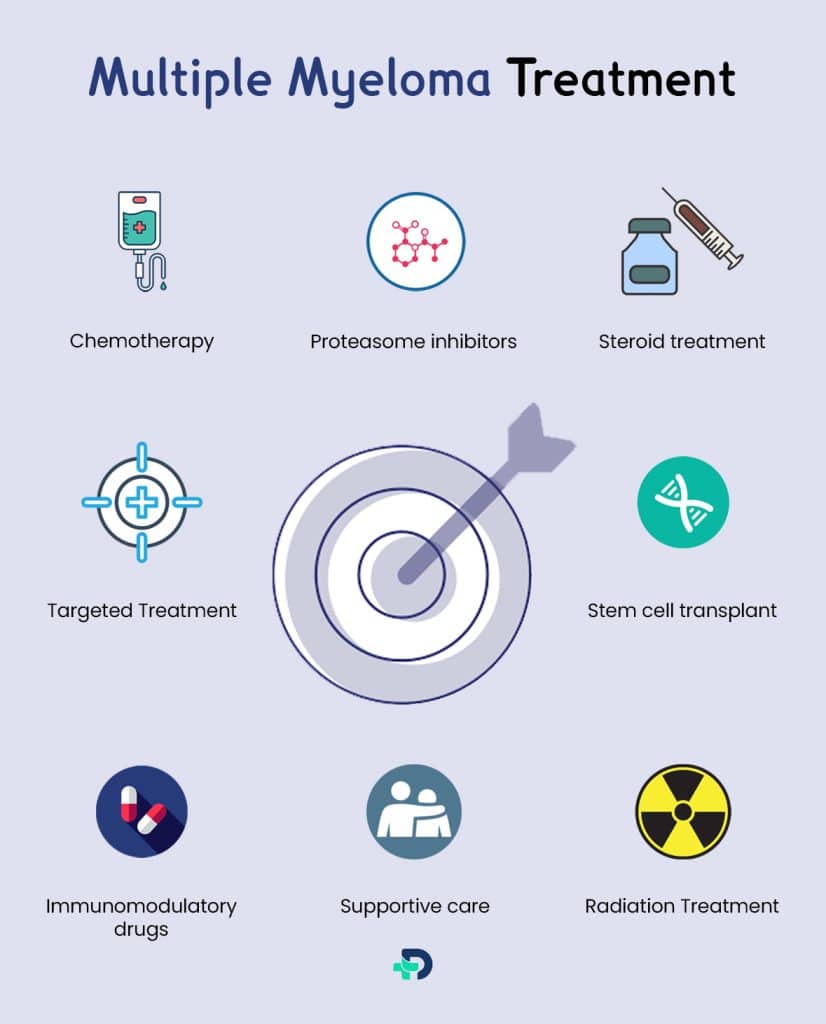Multiple Myeloma: Symptoms, Causes and Treatment

- Multiple Myeloma
- 22 Aug 2023
Overview
About Multiple Myeloma
The plasma cells, a white blood cell that produces antibodies to aid the body in fighting infections, are where multiple myeloma develops. In this disorder, the bone marrow is overrun by aberrant plasma cells that proliferate out of control and crowd out regular blood cells. It can damage bones, compromise the immune system, and cause anemia.
As we explore the world of multiple myeloma in this article, we’ll learn more about its causes, symptoms, and effects on patients’ lives. We will investigate the complex biology of plasma cells, the emergence of this malignancy, and the difficulties it poses for both patients and medical professionals1Overview| Researched based study from Nlm.nih.gov

Symptoms
Symptoms of Multiple Myeloma
Numerous symptoms may be present and may differ from person to person. Common signs of the condition include:
- Bone pain
- Fatigue
- Frequent infections
- Easy bruising and bleeding
- Unintended weight loss
- Kidney problems
- Nausea and constipation
- Hypercalcemia
A bone pain
- Consistent, inexplicable bone pain, particularly in the back, ribs, hips, and head, is one typical symptom. The weakening and destruction of bones brought on by the aberrant plasma cell development is a common cause of this discomfort.
Fatigue
- Anemia-related weariness or the effects of cancer on general health are two possible causes.
Multiple infections
- As the aberrant plasma cells impair the immune system’s capacity to fight infections, people may encounter recurring illnesses, including pneumonia or urinary tract infections.
Easy bruising and bleeding
- When healthy blood cells are squeezed out by malignant cells, platelets are reduced, which makes bleeding and bruising more likely.
Abnormal loss of weight
- Unintentional weight loss can happen to certain people for various reasons, including cancer and how it affects appetite and metabolism.
Kidney issues
- It may cause symptoms like increased thirst, frequent urination, and leg edema due to poor renal function.
Nausea and diarrhea
- Some patients may encounter nausea and constipation, brought either by the buildup of aberrant proteins or treatment-related adverse effects.
Hypercalcemia
- High blood calcium levels brought on by cancer-related bone deterioration induce symptoms including frequent urination and disorientation initially.
Remembering that these symptoms might also be a sign of several other illnesses is crucial. It is essential to seek medical assistance if someone experiences persistent or alarming symptoms so that a complete assessment and accurate diagnosis can be made for the problem to be treated and the end results to be improved, early diagnosis and prompt treatment are crucial.3Symptoms| Researched based study from Nlm.nih.gov
Causes
Causes of Multiple Myeloma
It is believed that a confluence of genetic and environmental variables is at fault, while the exact causes are not fully understood. Several essential elements that might play a role include:
Genetic predisposition
- There is evidence that it runs in families, suggesting a genetic predisposition. The risk may rise in the presence of specific congenital abnormalities or mutations.
Age
- Most instances are diagnosed in adults over 65, and the risk rises with age.
Ethnicity and race
- Asians and Caucasians experience it less frequently than African Americans do.
Gender
- Men are slightly more likely than women to be affected by the disorder.
Undetermined Significance Monoclonal Gammopathy
- The main feature of this benign sickness is the presence of abnormal proteins in the blood.
Radiation and chemical exposure
- Long-term exposure to high radiation levels and specific substances may raise the risk.
Obesity
- According to research, obesity may increase the risk of developing multiple myeloma.
Weakened immune system
- The risk may rise due to specific illnesses or drugs that weaken the immune system.5Causes| Researched based study from ResearchGate.net
Diagnosis
Diagnosis of Multiple Myeloma
Several examinations and testing go towards making the diagnosis. Since the disease may not always show visible signs in the early stages, a regular blood test or the occurrence of particular symptoms may help encourage a diagnosis.
Typically, the following steps are involved:
A physical examination and medical history
- A full medical history will be obtained, and a physical examination will be performed to check for any signs of disease or other symptoms.
A blood test
- The diagnosis depends on them. Low platelet and red blood cell counts can be detected using complete blood counts. In contrast, immunofixation tests and serum protein electrophoresis can show whether aberrant proteins were created by the cells.
Urine test
- To find the presence of aberrant proteins (Bence Jones protein) in the urine, tests such as urine protein electrophoresis are carried out.
Aspiration and biopsy of the bone marrow
- This entails using a needle to extract bone marrow from the hip bone. For the purpose of estimating the number and nature of plasma cells, the sample is examined under a microscope.
- The test helped establish the percentage of aberrant plasma cells in the bone marrow and validated the diagnosis of multiple myeloma.
Imaging test
- Bone damage and the severity of the disease are accessed via tests, including X-rays, CT scans, MRIs, or PET scans. They aid in identifying Bond lore or induced fractures.
Additional test
- Further tests, including cytogenetic testing and fluorescence in situ hybridization (FISH), may be conducted to assess cell genetic abnormalities affecting treatment choices.
“CRAB” Criteria
- The “CRAB” criteria—calcium evaluation, renal insufficiency, bone lesions, and anemia—and the presence of a sizable number of aberrant plasma cells in the bone marrow—must all be met for the diagnosis to be considered definite.4Diagnosis| Researched based study from Nlm.nih.gov
Treatment

Multiple Myeloma Treatment
It depends on a number of factors, including the extent of the illness, the patient’s general health, and the distinctive characteristics of the cancer cells. Controlling the development of aberrant plasma cells, symptom relief, and quality-of-life enhancement are the main targets of treatment.
Chemotherapy
- To eliminate or regulate cancer cells, medications are used. Chemotherapy may be administered along with other therapies to kill multiple myeloma cells.
Targeted treatment
- These medications target particular proteins or pathways that are important in the development of cancer cells. These can be used on their own or in combination with other treatments.
Immunomodulatory drugs
- Thalidomide, lenalidomide, and pomalidomide are drugs that improve the body’s immunological response to cancer cells.
Proteasome inhibitors
- Bortezomib, carfilzomib, and ixazomib prevent the breakdown of proteins in cancer cells, which causes the cells to die.
Steroid treatment
- Prednisone or dexamethasone are examples of steroids that can assist in managing information and lower aberrant protein levels in the blood.
Stem cell transplant
- On suitable individuals, high-dose chemotherapy followed by a stem cell transplant can be used to replace the damaged bone marrow with healthy stem cells.
Radiation treatment
- It can ease pain or shrink tumors by concentrating on specific areas of bone deterioration.
Monoclonal antibodies
- Daratumumab and elotuzumab are two examples of monoclonal antibodies that can target a particular protein in cancer cells to aid the immune system’s fight against the disease.
Supportive care
- To effectively handle many issues, including the patient’s overall well-being, care encompassing pain management therapy for anemia or infection and bone-strengthening drugs play a significant role.
Based on each patient’s unique heat and response to therapy, treatment plants are customized for them. To help keep the condition under control, some patients may undergo multiple lines of treatment over time, including maintenance therapy. It’s crucial to follow up frequently with healthcare professionals to track the course of the condition and modify treatment as necessary.2Treatment| Researched based study from Nlm.nih.gov
Is multiple myeloma curable?
- There is still no cure for the illness. Many patients can achieve remission or long-term disease control with the use of the currently available medications, thereby lengthening their lives and increasing their quality of life.
- It is a challenging and complex disease, and not every patient will respond to treatment similarly. Relapses can also happen, necessitating the need for new lines of therapy.
Any feedback on this article?
 This Articles content was accurate
This Articles content was accurate Very Informative Article
Very Informative Article I have a question or a comment
I have a question or a comment
 This article contains inaccurate content
This article contains inaccurate content This article was not helpful
This article was not helpful I have a question or a comment
I have a question or a comment
We appreciate your helpful feedback!
Checkout our social pages
References
-
National Library of Medicine
Multiple Myeloma | Overview
-
National Library of Medicine
Multiple myeloma: an overview of management | Treatment
-
National Library of Medicine
The Clinical Characteristics of Multiple Myeloma in the Acute Care Setting: Case Presentation and Clinical Recommendations | Symptoms
-
National Library of Medicine
Multiple Myeloma: Diagnosis and Treatment | Diagnosis
-
Research Gate
Multiple myeloma: Causes and consequences of delay in diagnosis | Causes






































